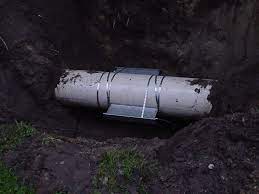Flowmeter
This technique is used to derive the (local) groundwater flow (direction and magnitude) directly around a horizontally placed monitoring well (local groundwater flow). For this, the flow meter is installed in a monitoring well. This measures the groundwater flow on the basis of the temperature trend in the monitoring well.
| General information | |
| Name | Flow meter, also known as Geoflow probe. Alternative Technique: Phrealog. NB not to be confused with the [ Geoflo ]. |
| Unit of measure and parameter | Temperature translated to groundwater flow (size and direction) |
| Soil phase | groundwater |
| Nature technique | Physical and probe/sensor |
| Place of application | in situ |
| Detection Mode | Measurement at ground level / water bottom |
| Applicable in separate layers | Yes, minimum layer thickness: approx, 0.5 m |
| Soil types for which technology is suitable |
|
| Land soil/water bottom | Land soil |
| Step in the data collection chain | Run-up, Drilling / Penetrating / Instr. Placement, Sampling or Measure |
| Moment of availability results | Measurement results are available in the field |
| Technology development phase | widening phase and applied routinely |
| Method of purchasing | as service, as a product or as a device |
| General description of the implementation method | A probe is installed in a horizontally slotted 2- or 4-inch standard monitoring well. The local groundwater flow (direction and magnitude) is derived using the probe. |
| Working principle | The probe is installed in a horizontally slotted monitoring well. There is a heating element in the core of the probe. This element gives off a heat pulse. Around the core are a number of heat sensors/thermistors. The position of the sensors is precisely oriented with a compass. A resultant (vector) is obtained from the temperature differences between the heat sensors, which is representative of the groundwater flow direction and speed. For each type of filter, the probe must be calibrated in a flow cell. |
| Point / line measurement / volume measurement | point measurement |
Technical specifications (including accuracy) | Measuring range: 0.03 m/day – 150 m/day Sensitivity: 0.03m/day Probe applicable in 2- or 4-inch monitoring wells |
| Typical depth range | In practice monitoring wells are usually trenched to a depth of 10 meters. The length of the monitoring well is a maximum of 135 meters (cable length). Moreover the sensitivity is independent of the depth |
| Time properties | Measuring takes approximately 2 hours. The method is suitable for repeat measurements to measure variations of the groundwater flow direction over time or to determine the direction accurately (at low groundwater flow rates). |
| Measuring rate | If a suitable monitoring well is available, the measurement will take approximately 2 hours. |
| Presentation results | Display derived groundwater flow (size and direction), including individual vectors |
| cost | Approximately €150 per measurement, excluding advice and installing monitoring well. |
User information | |
| Availability | one or a few providers in NL |
| Is technology often used? | occasionally |
| Research phase in which technology can be applied | Explore and monitoring |
| Verification measurements / calibration measurements | are often used |
| Frequently used application in practice | Establishing groundwater flow pattern in connection with the spread of groundwater contaminants, dimensioning cold-heat storage systems, monitoring landfills. |
| Suitability | Suitable for saturated soil. In theory usable in any type of soil (clay, peat, sand). But in view of the measurement objective (horizontal groundwater flow) mainly to be used in aquifers (sandy) layers. The measurements only provide a representative picture of the situation directly around the monitoring well (local groundwater flow). Due to differences in soil composition (also horizontal), it may deviate from the regional picture. Measurement takes place in a small part of an (water-bearing) layer. The measurement does not have to be representative of the entire layer. Measurement is influenced by local groundwater flow around the monitoring well and thus by the method of drilling and filter design. Monitoring well must have a minimum inside diameter of 2 inches. |
| Practical experiences in the Netherlands | The technique is still rarely used in practice. Where it is applied, the results are very useful. Given the results and the application for which the technology can be used, you would expect the technology to be used more often. |
| “Dos“ | Monitoring well must be placed level, otherwise an incorrect position of heat sensors will be calculated. Place the sensor in a properly finished and constructed monitoring well (refill, filter). |
| Also suitable for | Dimensioning ATES systems. |
Referentie
Inhoud
